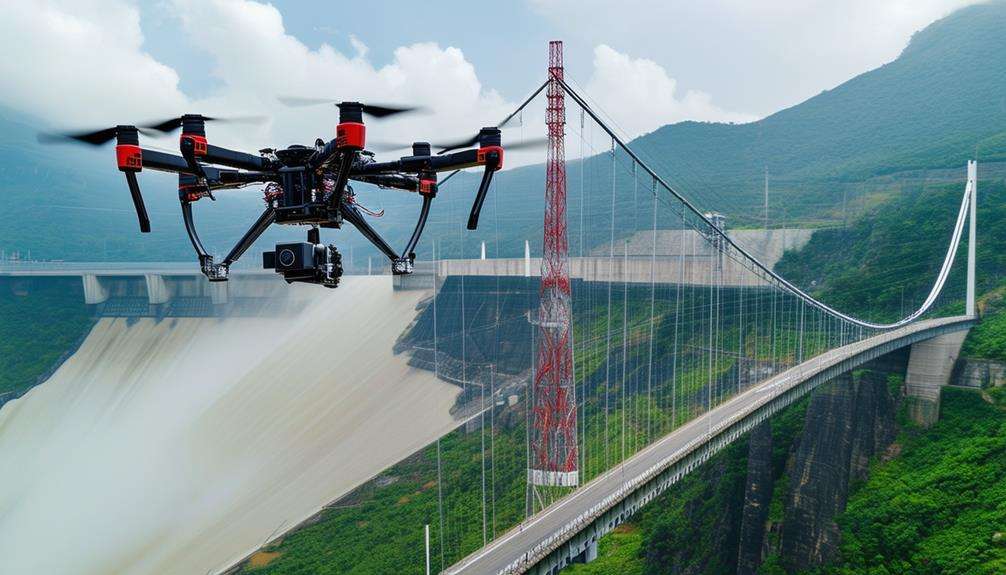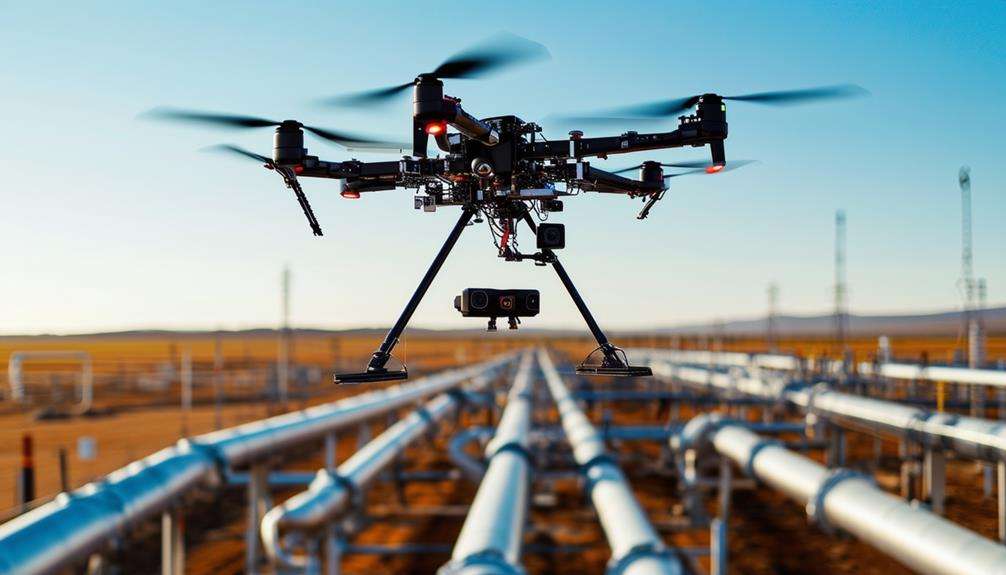The Role of Drones in Power Line Inspections
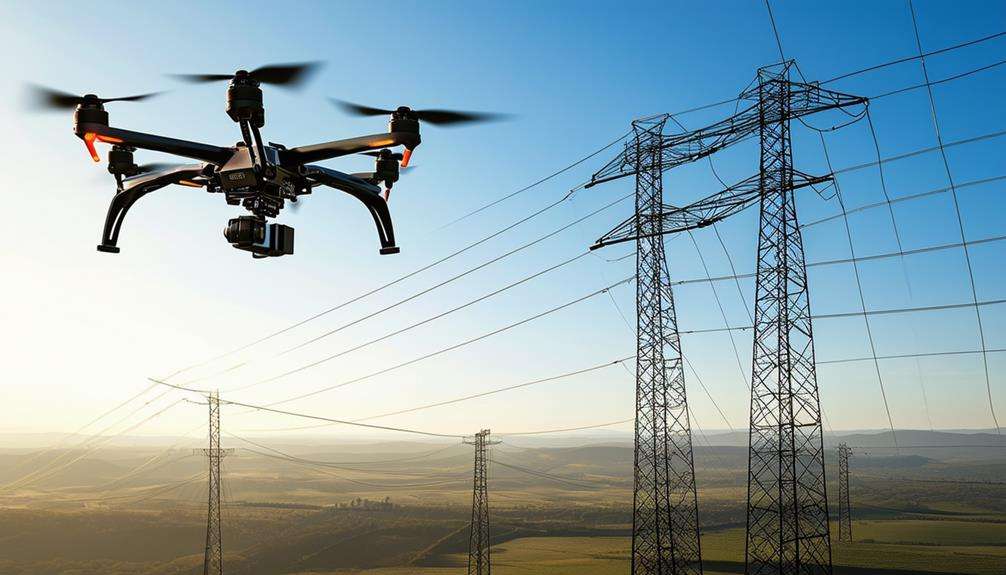
When you think about power line inspections, the initial concerns are likely high costs, safety risks, and significant time investments. However, drones have the potential to revolutionize this process.
By integrating drones into inspection routines, utilities can achieve more efficient, safer, and cost-effective outcomes. These advanced tools provide precise imagery and early fault detection, significantly enhancing system reliability.
Interested in how drones can identify issues that traditional methods might overlook? Let's explore the transformative impact of drones on power line maintenance and understand why they are becoming indispensable in the industry.
Current Challenges in Power Line Inspections
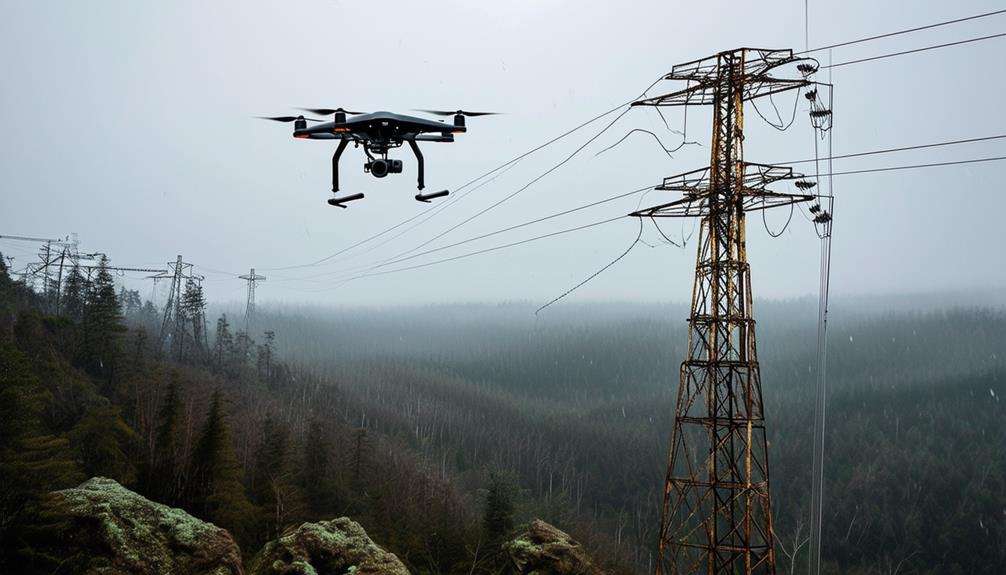
Manual power line inspections are fraught with risks and inefficiencies, often requiring over a year and a large team to gather visual data. Traditional methods involve inspectors using binoculars, rope access, scaffolding, and cranes, which expose them to serious hazards like falls. This approach not only compromises their safety but also demands substantial time and resources.
While manned helicopters equipped with high-resolution cameras offer an alternative, they come with exorbitant costs, frequently exceeding $4,000 per day, excluding maintenance expenses. The sheer number of local distribution lines exacerbates these inefficiencies, underscoring the need for a more effective solution.
Drones offer a compelling alternative for power line inspections. Capable of accessing hard-to-reach areas, drones enhance transmission line safety and facilitate comprehensive data collection. They're particularly adept at monitoring vegetation encroachment, crucial for preventing outages. Equipped with thermal imaging sensors, drones can detect issues invisible to the naked eye, such as hotspots or damaged components.
Benefits of Drones for Inspections
Drones offer a cost-effective and safer alternative for power line inspections, reducing expenses by up to 50% while delivering more accurate data. By deploying drones, you can significantly cut costs associated with traditional inspection methods, including labor, equipment, and logistics.
Drones enhance safety by eliminating the need for human inspectors to physically navigate hazardous and hard-to-reach areas. This not only improves worker safety but also allows for more frequent inspections, thereby increasing the system's reliability and performance.
Drones capture high-quality imagery and video, enabling precise detection of maintenance issues and defects. This detailed data collection allows you to identify potential problems before they escalate, ensuring timely maintenance and reducing the risk of power outages.
Here's a quick overview of the benefits:
| Benefit | Description | Impact |
|---|---|---|
| Cost Reduction | Reduces inspection costs by 30-50% | Lower operational expenses |
| Improved Safety | Eliminates the need for dangerous manual inspections | Enhanced worker safety |
| Accurate Data | Captures high-quality imagery and video | Precise identification of maintenance needs |
| Faster Inspections | Quicker than traditional methods | More frequent and efficient monitoring |
| Defect Identification | Detailed detection of defects and faults | Improved maintenance and system reliability |
Embrace drones for your power line inspections to experience these transformative benefits firsthand.
Drone Applications in Power Line Inspections
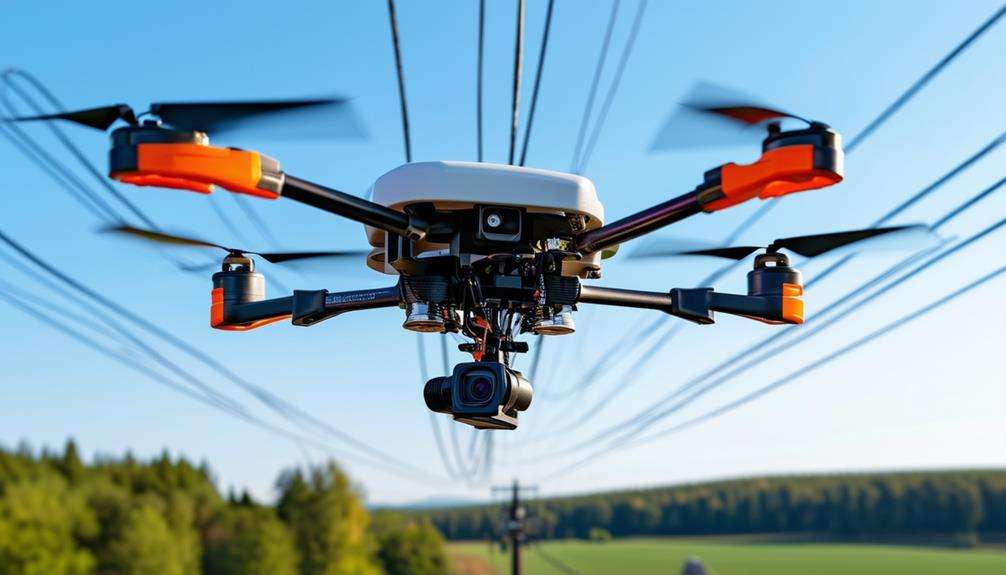
Harnessing the numerous advantages of drones, we delve into their specific applications in power line inspections. Drone technology has revolutionized the safety and reliability of power line maintenance. With drone inspections, monitoring vegetation encroachment becomes highly effective by accurately measuring distances from power lines, thereby preventing outages and ensuring a safer grid.
Drones streamline power line inspections by minimizing the need for on-site personnel, which significantly reduces costs and lowers risks to human inspectors. Equipped with thermal sensors, drones play a vital role in wildfire inspection and prevention. They can identify hot spots and other anomalies, enabling rapid responses to avert catastrophic damage.
In addition, drones excel in grid status monitoring. They capture detailed images and data on the grid's condition, allowing for early detection of faults and defects before they escalate into major issues. This real-time monitoring ensures the power network remains reliable and efficient.
Here are three key applications of drones in power line inspections:
- Monitoring Vegetation Encroachment: Drones provide precise measurements to prevent vegetation from interfering with power lines.
- Detecting Faults and Defects: High-resolution images and data help identify issues early, ensuring timely maintenance.
- Wildfire Inspection and Prevention: Thermal sensors detect hot spots and anomalies, facilitating quick interventions to prevent wildfires.
Types of Maps From Drone Inspections
Drone-generated maps are indispensable for power line inspections, offering various forms that provide unique insights and advantages.
- Thermal Maps: These are essential for detecting issues such as abnormal voltage and contact resistance, which could indicate potential problems in power lines. Thermal imaging allows for early identification and resolution of these issues, preventing major failures.
- LiDAR Technology: JoLiDAR provides highly accurate position and orientation data, enabling the creation of detailed 3D models of power line structures. JoLiDAR-LR enhances this further by offering superior data accuracy and point cloud density, providing a comprehensive view of the power line environment. These 3D models are crucial for precisely calculating distances and heights of power lines and surrounding obstacles.
- Orthographic Cameras: These cameras capture stable, high-resolution images, essential for thorough inspections.
- Gimbal Cameras: These offer flexibility and stability, ensuring clear images from various angles.
Together, these technologies form a robust toolkit for efficient and accurate power line inspections, contributing to the maintenance of a reliable power grid.
Best Drones for Power Line Inspections
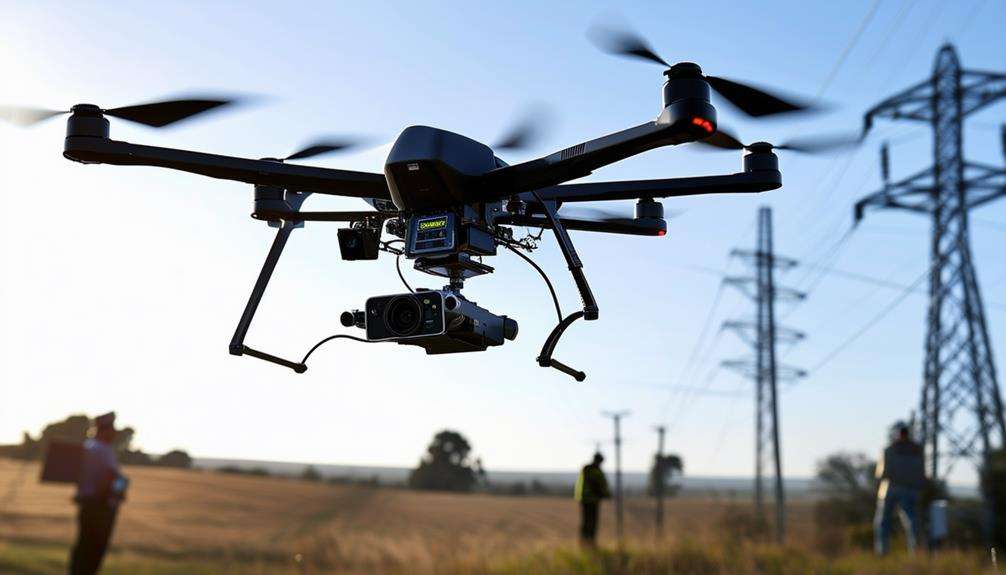
When searching for the best drones for power line inspections, consider leading models from JOUAV and Inspired Flight Technologies. Essential features include high payload capacities, obstacle avoidance systems, and specialized cameras like the CA-103 and MG-120 Gimbal Camera. Performance and reliability are paramount, with technologies such as LiDAR ensuring precise data collection.
Top Drone Models
Several top drone models stand out as the best choices for power line inspections due to their advanced features and capabilities. When selecting the right drone, consider factors like obstacle avoidance, camera quality, and operational versatility.
Here are some top contenders:
- DJI Matrice 300 RTK: This drone is highly suitable for power line inspections, offering up to 55 minutes of flight time and a suite of advanced safety features. Its obstacle avoidance system ensures smooth maneuvering through complex power line structures.
- Skydio 2: Known for its exceptional obstacle avoidance capabilities, the Skydio 2 excels in navigating challenging environments. Its AI-driven camera modes allow it to automatically track and capture detailed footage, making it ideal for intricate inspections.
- Autel Robotics Evo II Pro: This model features a 6K camera resolution and a 40-minute flight time, making it a popular choice for power line inspections. Its high-quality imaging capabilities enable the identification of even the smallest anomalies.
Other notable mentions include the DJI Mavic 2 Enterprise Dual, equipped with a thermal imaging camera for spotting hotspots, and the PowerVision PowerEgg X, offering AI camera modes and a weatherproof design, enhancing inspection versatility.
Key Features Overview
Selecting the right drone for power line inspections involves understanding the key features that distinguish certain models. When inspecting utility power lines, a drone with high payload capability is essential. JOUAV drones are recommended for their ability to carry advanced equipment like the MG-120 Gimbal Camera, which integrates both infrared and optical sensors for detailed analysis and fixed-point inspections.
Obstacle avoidance systems are crucial for ensuring that commercial drones can safely navigate the complex structures around power lines. Drones from Inspired Flight Technologies are designed specifically for industrial and governmental use, excelling in this area.
LiDAR technology provides precise position and orientation data, which is vital for accurate analysis of power line structures. JoLiDAR is particularly noteworthy, enhancing the inspection process with detailed 3D mapping.
Performance and Reliability
Investing in drones from Inspired Flight Technologies offers unparalleled performance and reliability for power line inspections. These drones are designed for heavy lift capacities, enabling them to carry high-resolution cameras and LiDAR scanners for comprehensive data collection. Real-time data processing and end-to-end solutions streamline fault inspections and utility operations, making them both efficient and effective.
Reliability in inspections is crucial for maintaining infrastructure integrity. Inspired Flight Technologies' drones enhance operator safety by providing multiple angles to analyze voltage, monitor vegetation encroachment, and detect abnormalities. This comprehensive approach minimizes risks and boosts overall productivity.
Key benefits include:
- Improved Efficiency: Real-time data processing and diverse inspection angles facilitate quick detection of faults and abnormalities, conserving time and resources.
- Enhanced Operator Safety: Drones reduce the need for manual inspections, lowering the risk of accidents and exposure to hazardous conditions.
- Thorough Data Collection: Heavy lift drones equipped with advanced sensors deliver detailed insights, ensuring meticulous inspections and precise maintenance planning.
Real-World Drone Applications
Drones are invaluable in real-world applications such as surveillance and monitoring of power lines. They enhance fault detection efficiency by quickly identifying issues and providing precise data. This enables maintenance teams to respond promptly to potential problems and thereby boosting grid reliability.
These unmanned aerial vehicles play a crucial role in improving the overall performance and safety of power grids. By conducting regular inspections from the air, drones help utilities to minimize downtime and prevent costly outages.
Surveillance and Monitoring
Drones have transformed power line inspections by offering real-time surveillance, fault detection, and efficient vegetation management. Utilizing advanced technology, these devices ensure the optimal condition of power grids. Equipped with high-resolution cameras and thermal sensors, drones capture detailed aerial views of powerline corridors, facilitating frequent and comprehensive inspections. By employing drones, utilities can maintain a reliable and safe power grid through advanced, efficient surveillance and monitoring.
- Fault Detection: High-resolution cameras and thermal sensors quickly identify rust, damaged components, and other issues.
- Vegetation Management: Drones monitor tree growth and other vegetation near power lines, reducing the risk of outages and fires.
- Real-Time Data Collection: Drones provide immediate insights into the grid's status, enabling prompt maintenance actions.
Fault Detection Efficiency
In real-world applications, drones can quickly and accurately detect faults in power lines, ensuring grid reliability and reducing the risk of outages. When conducting drone inspections of transmission lines, you benefit from their precision and agility. These drones efficiently identify issues such as corrosion, damaged insulators, and loose hardware, allowing for early fault detection.
By pinpointing defects using advanced sensors and imaging capabilities, drones provide utility companies with detailed and accurate data. This data is crucial for efficient fault detection, enabling improved maintenance strategies. Consequently, you can prevent costly repairs and minimize downtime, thus optimizing grid performance.
Drone inspections of transmission lines offer unparalleled efficiency, allowing you to identify problems before they escalate. This proactive approach ensures thorough and effective utility power line inspections. Leveraging drone technology not only enhances grid reliability but also optimizes maintenance operations.
The result is a more resilient and dependable power grid, capable of meeting increasing energy demands. If you aim to boost your utility's performance, integrating drones into your inspection routine is a transformative step.
Top Software for Drone Inspections
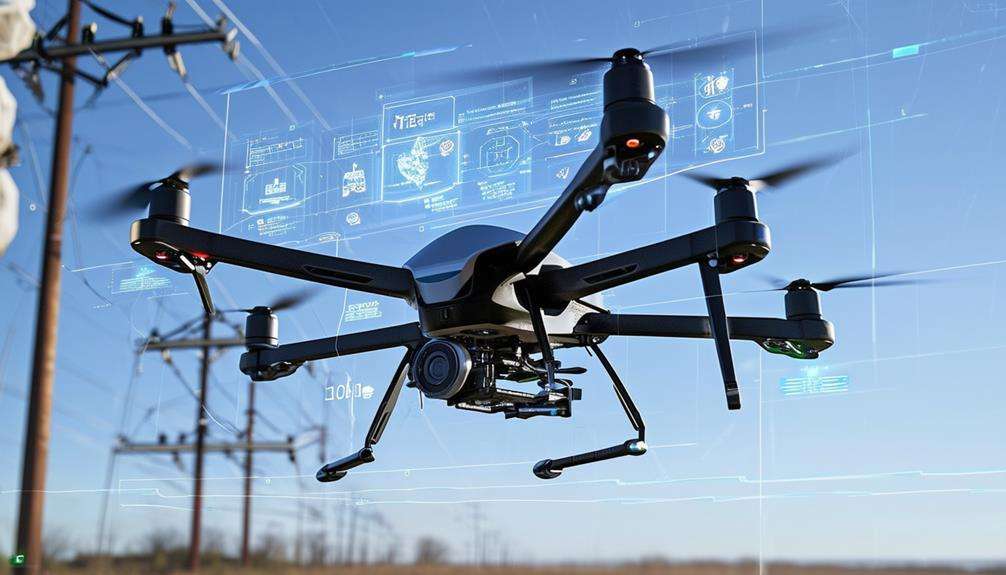
The success of drone-based power line inspections often depends on the quality and capabilities of the software used. The right tools can significantly enhance the efficiency and accuracy of these inspections.
FlightSurv software comes highly recommended for such operations. This advanced software offers features like autonomous flight and map generation, streamlining the inspection process. By enhancing data management and analysis capabilities, FlightSurv ensures accurate inspections and thorough data collection.
For a deeper understanding of how to utilize specialized software for drone inspections, refer to the Thundercloud e-book. This comprehensive guide provides valuable insights into drone operations and software usage, maximizing the efficiency of your inspections.
The importance of specialized software in drone-based power line inspections can't be overstated. Efficient data processing and detailed analysis are crucial for identifying issues and maintaining power lines. Advanced tools like FlightSurv optimize these processes, ensuring the most accurate and actionable data.
Key points to consider:
- Autonomous flight and map generation
- Enhanced data management and analysis
- Comprehensive guides like the Thundercloud e-book
Getting Started With Drone Inspections
Embark on your drone inspection journey by selecting the right equipment and understanding regulatory requirements. Opt for drones designed for power line inspections with ferromagnetic shielding to prevent electromagnetic interference, ensuring accurate data collection.
Familiarize yourself with local and national guidelines governing drone operations to ensure compliance. Conduct a thorough site assessment before flying to identify potential hazards and obstacles. This step is crucial for the safety and efficiency of your inspection.
Develop comprehensive flight plans detailing routes, waypoints, and focus areas to capture all necessary footage. These plans help identify issues that might be overlooked during traditional inspections.
Ensure your drones are flight-ready with sufficient battery life and strong signal strength. Regular maintenance of transmission lines can be significantly enhanced by drones, offering more detailed visuals compared to ground-based methods.
Successful power line inspections hinge on preparation, regulatory adherence, and proper equipment selection. By focusing on these elements, you'll conduct effective inspections and ensure thorough and efficient transmission line maintenance.
Conclusion
Drones are revolutionizing power line inspections by addressing current challenges and offering numerous benefits. Leveraging advanced technologies such as LiDAR and thermal imaging, drones enable precise defect identification, detailed mapping, and enhanced system reliability. Real-world applications and leading software solutions validate their effectiveness. Ready to elevate your maintenance practices and improve safety? Start integrating drones into your inspections today and experience the forefront of power grid management.


